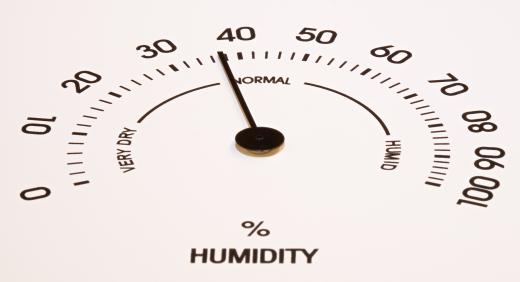What is a Humidity Chart?
A humidity chart is used to determine the characteristics of air in various conditions. Determining humidity is important in many manufacturing processes, including pharmaceuticals, microelectronics, and medical devices and equipment. It can affect the expansion and contraction of a material, liquid flow properties, growth of bacteria, and the rate of corrosion and rust. There are different types of humidity charts available.
A humidity chart is a tool that helps people interpret how the level of moisture in the air will change as the surrounding environment changes. Humidity is a measure of the presence of water vapor in air or gas. Water vapor is formed in the air when evaporation occurs, or when hot water produces steam. The amount of water vapor that can be absorbed by the air depends mainly on temperature. Higher temperature air has the capacity to absorb more water vapor.

A psychometric chart shows several common properties of air at different conditions. These charts are often used by engineers to design and optimize the performance of heating, ventilating, and cooling systems. The air properties on a psychometric chart include dry-bulb temperature, wet-bulb temperature, relative humidity, humidity ratio, specific volume, dew point temperature, and enthalpy. Any two known values can be used to determine the overall state of the atmosphere by reading the desired values directly off of the chart. Different psychometric charts are required for low, medium, and high air temperatures.

A relative humidity chart provides a quick and reliable way to determine the amount of moisture in the air. Relative humidity is a measure of the amount of water vapor in an air or gas, compared to the maximum amount of water vapor that can be absorbed at a given temperature. A relative humidity chart can be used to determine the humidity inside a home at different outdoor temperature conditions. This chart is often used as a guide for setting and adjusting humidifiers, to provide a comfortable level of humidity inside a home during dry winter months.

Another type of humidity chart shows the impact of relative humidity on air quality characteristics, such as bacteria growth, viruses, respiratory infections, allergic reactions, ozone production, and more. It can reveal how relative humidity affects the growth and severity of each condition over a range from zero to 100 percent. The optimum zone for relative humidity is often shown on the plot. An excessive or inadequate amount of moisture in the air can cause adverse health effects. It is important to maintain relative humidity at a level that minimizes potential risks.
AS FEATURED ON:
AS FEATURED ON:













Discussion Comments
what's the major difference between humidity chart and psychrometric chart? are they both same?
Post your comments